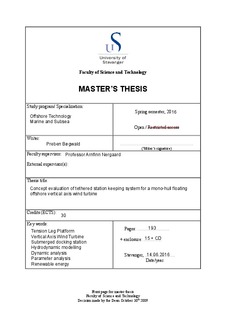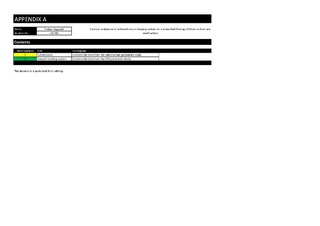| dc.description.abstract | The objective of this thesis is to perform a concept evaluation of novel station keeping concept for offshore vertical axis wind turbines based on the well-known tension leg platform (TLP) principle. The main characteristic of this concept is the two-stage approach of installing the turbine offshore. In general terms the concept consists of four major components: the turbine, cylindrical floater, submerged docking station and an array of vertical top tensioned tethers. The idea behind this concept is that the docking station is towed out to the field and attached to the tethers prior to the float out operation of the turbine. The turbine is towed out on separate cylindrical floater, which is mated to the docking station, situated at a certain depth below sea level. The top-tensioning of the tendons is achieved in two stages, first by de-ballasting the docking station to maintain a level of pre-tension prior to the mating procedure with the turbine floater. The turbine floater, which also maintains a certain mass of temporary ballast to achieve operating draft, is later used to achieve the desired pre-tension for the operating condition after installation. This concept was applied for patenting in Norway by Prof. A. Nergaard on 31st June 2009 and granted 20th September 2010 (Patent no. 329254).
In this thesis the aim was to determine a set of promising floaters and docking stations by assessing relevant parameters based on spreadsheet calculations. The key considerations here were sufficient pre-tension capacity and stability in float out for a vertical axis wind turbine with a rated power of 2.3 MW. Adjustments were made to the principal dimensions such as the diameters, drafts, pontoon radii and ratios of permanent ballast to temporary ballast to achieve stable floaters and docking stations that satisfied a set of design criteria. Due to limited available research on this particular concept, the design criteria were set based on existing information on horizontal axis wind turbine TLPs, along with several engineering assumptions.
In general terms the work presented in this thesis cover three principal stages: spreadsheet analysis of parameters, hydrodynamic modelling and dynamic simulation in one operational and extreme sea state. The parameter study resulted in the selection of three cases with combined displacements ranging between 6047 and 9811 m3, with associated pre-tension capacities per tendon between 5.3 and 10 MN. Following the selection of cases, work was done to determine the frequency dependent added mass and potential damping properties of each case along with the specification of load and displacement RAOs. These properties were used to create a new set of vessels in OrcaFlex to assess the motion characteristics and tendon tension for the two aforementioned environmental conditions. The analysis conducted in this thesis was limited to linear effects only, i.e. second order effects were neglected.
The objective of the thesis was to evaluate this concept based on the results obtained from the dynamic simulation in terms of loads at the floater-docking station connection, the tension in the tendons under both environmental conditions and assess the motion characteristics of each case.
The results obtained for the selected cases resulted in slack tendons in the severe sea state corresponding to a 50- year storm, which indicated that the selected cases did not satisfy the requirement for this type of station keeping concept. Despite the fact that none of the cases were sufficient to survive the storm, some trends were uncovered for possible further work on this concept to reach a suitable combination of parameters. The main problems that were found for this concept was the bending moment at the connection between the floater and docking station, and the occurrence of slack. In the 50-year storm, maximum bending moments between 270 and 320 MNm were found, exceeding the capacity of standard collet connectors, which was the envisioned connection method in this thesis.
In regards to slack tendons, it was found here that an increased pontoon radius (>35 m) would yield significantly improved results in terms of avoiding slack, which coincided with the studied literature. A reduction in draft of the floater component, which in this thesis ranged between 50 and 60 m, would also result in improvements for both the connection load and the loss of tension in the downwind tendon. Higher pre-tension was also found to give lower variation in tendon load, coinciding with the studied literature | nb_NO |


